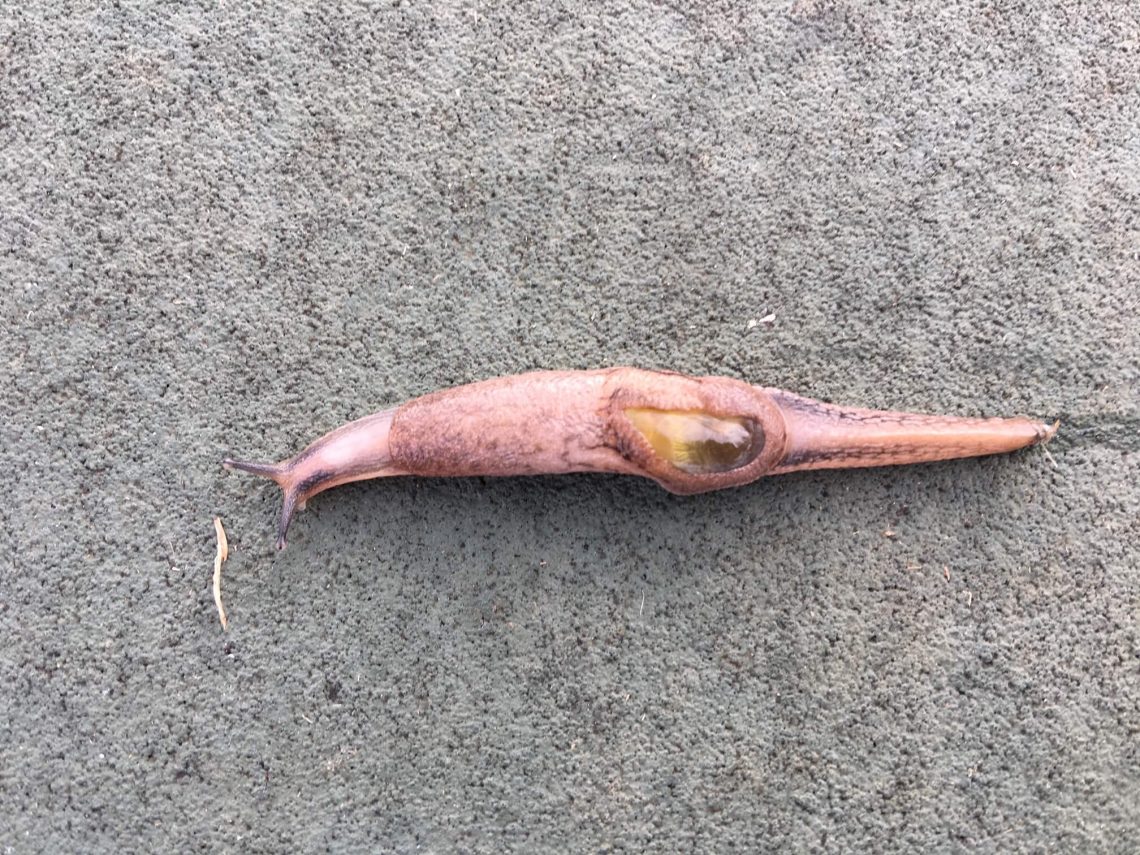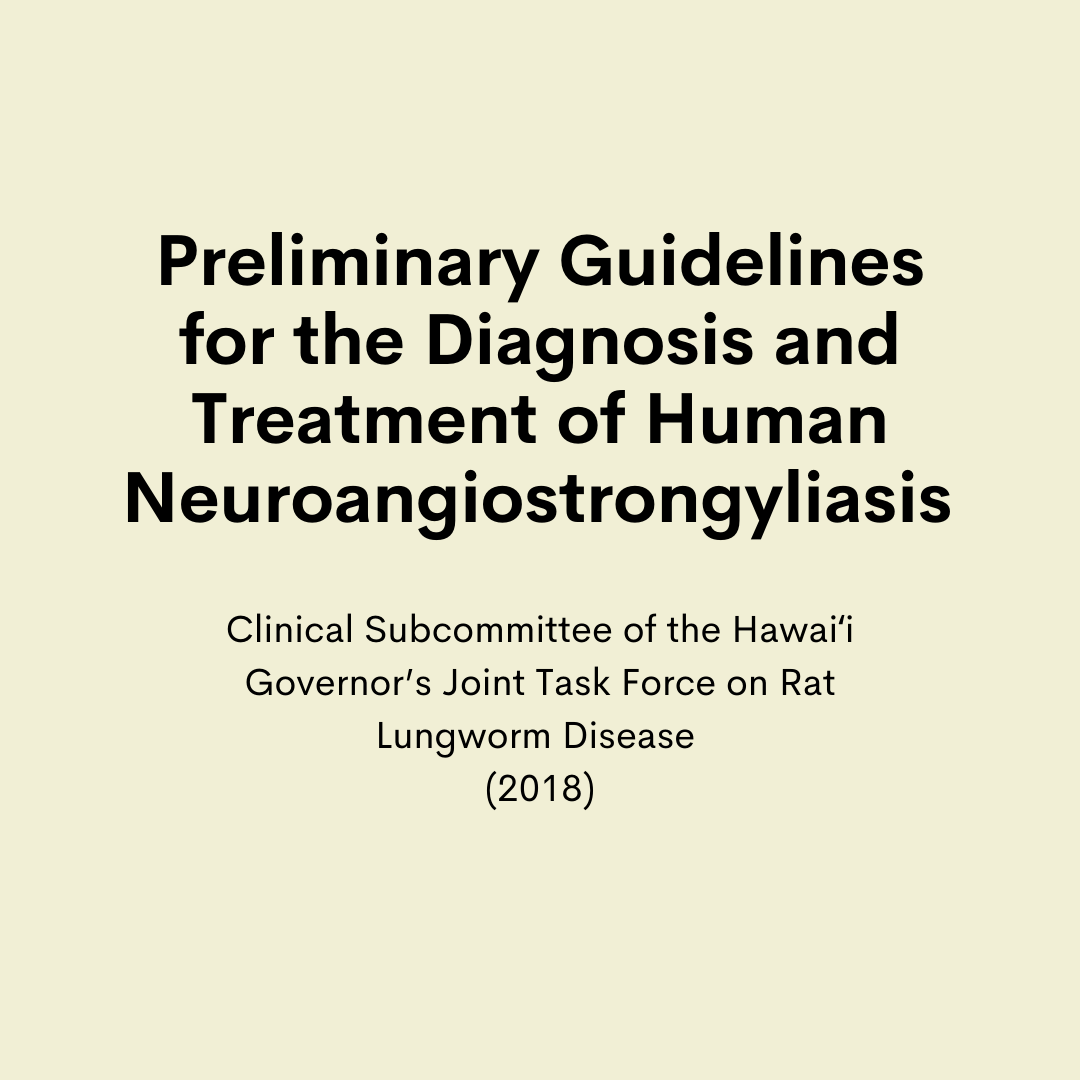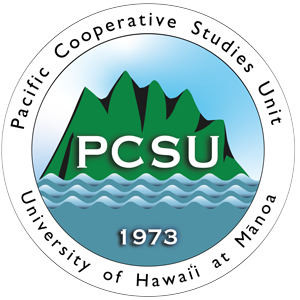
Rat Lungworm Disease
Caused by the parasite Angiostrongylus cantonensis, rat lungworm disease (RLWD) is a serious health concern in Hawai‛i. The parasite is a nematode (worm) with a two-host life cycle, meaning that to move completely from egg to reproducing adult, it must spend part of its life in two different animals. This cycle starts in the lungs of a rat, where eggs hatch into larvae that are passed in feces. Gastropods (slugs and snails) will then consume the rat feces, and the larvae will continue their development in the slug or snail until they are eaten by a rat, where they can reproduce and begin the next generation.
The danger for humans comes when we interrupt the second transition, by accidentally eating a slug or snail which has been infected with A. cantonensis larvae (rats do not shed larvae at a stage that is infectious to humans, but as other human diseases are spread in rats feces, contact and ingestion should be avoided). Disease symptoms range from mild illness to severe debilitation, coma, and even death. Many survivors of RLWD report permanent injury from the disease.
All snails and slugs – even endangered native snails – can carry the parasite, although one slug, in particular, has been associated with increased incidence and severity of disease. The Parmarion martensi, or “semi-slug,” has been show to have the ability to carry a very high parasite load, which may be associated with the level of severity of RLW disease. As of early 2019, the semi-slug has been confirmed as established from Volcano to Kalapana, through Hilo, and up the coast into North Kohala, and is quickly continuing to spread across the Big Island.

Jan 2020 Update: After the 6th International RLW Workshop, new information was made available that could help residents and visitors who accidentally consume a snail or slug. Based on guidelines from Australia and on preliminary research by collaborators including the Jarvi Lab, the commonly available OTC pinworm medicine containing the active ingredient pyrantel pamoate has been suggested as potentially helping to mitigate the development of serious disease. Remember to freeze any snail or slug pieces for testing to determine presence of the RLW parasite! Click here to read the full advisory.
How to reduce your risk
Rats have long been recognized as a very damaging invasive species, in Hawaii and around the world. The semi-slug, along with other introduced gastropods like African snails, Cuban slugs, rosy wolf snails and more, are considered agricultural pests and are the bane of Hawaii agriculturalists. Control of these pests has long been a struggle, but all residents of the Big Island are encouraged to control them as much as possible.
An Integrated Pest Management (IPM) approach which includes poisonous baits, trapping, reduction of habitat, and repellants that is appropriate for the location should be developed.
Be careful of all leafy greens. The only safe way to eat raw leafy greens is to thoroughly inspect and wash each leaf individually, and allow the leaves to dry before eating (parasites cannot survive drying out). Freezing for 24 hours or cooking are the safest approaches for consuming leafy greens. Other vegetables and fruits should be carefully inspected and washed thoroughly before consuming.
Resources
We, at BIISC, are not disease specialists, and we rely on research by the Jarvi Lab at the University of Hawai‛i-Hilo Daniel K. Inouye College of Pharmacy, as well as information received from the Hawai‛i State Department of Health and the CDC. We have collected resources for RLW and compiled them here in an effort to help people who are seeking assistance with these invasive pests and trying to protect themselves from RLW disease. If you have any additional resources that you believe would be helpful to add, please email us at biisc@hawaii.edu.
- Rat Lungworm Information Site from UH-Hilo College of Pharmacy
- Rat Lungworm Resources for Growers, General Public, Gardeners (with videos) from UH Extension CTAHR
- Angiostrongyliasis (Rat Lungworm Disease) site from Hawaii Dept. of Health
- Rat Lungworm Resources from Hawaii Dept. of Agriculture
- Angiostrongyliasis site from Center for Disease Control (CDC)
- Malama o Puna site for RLD in Puna & Big Island
- Information about Hilo Medical Center’s RLD Survivor Support Group
- Facebook RLW Awareness Page
- Video: Proper Washing & Prep of Veggies by UHH-DKICP
- Catchment Filters Testing Results by UHH-DKICP
- RLW and Water Catchment Brochure by UHH-DKICP
In the News
- Dec 2023 HNN Mom who nearly lost her child to RLD calls for more education, awareness
- Feb 2020 Civil Beat Scientists Say Many Rat Lungworm Cases In Hawaii May Go Unreported
- July 2019 Paper on Coqui & Other Paratenic Hosts
- July 2019 HNN Sixth case on the Big Island
- July 2019 New York Times Article on RLW in Hawaii
- May 2019 HNN Three new cases in visitors to Big Island
- April 2019 Civil Beat State confirms third case on BI
- Jan 2019 WHT New case RLD in East Hawaii infant
- Nov 2018 Star-Adv Two new cases of RLD on Big Island
- Aug 2018 WHT RLD confirmed in toddler on Big Island
- Aug 2018 Star -Adv New Medical Guidelines Released for RLD
- July 2018 HTH UH Team tracking snails, slugs & RLD
- Dec 2017 UH News RLW in Big Island Rats
- Apr 2017 Honolulu Mag 6 Things You Should Know
For Educators
- Webinar & Assorted lessons for teachers/school garden coordinators from Hawaii Farm-to-School Hui
- RLW Activity book, lessons & activities from UH-Hilo Daniel K. Inouye College of Pharmacy
- Plagues, Past & Present HS lesson on RLW from Ho’ike o Haleakala Curriculum
- RLW Citizen Science teacher PD by DKICP offered by BIISC
- Slug Jug Instructions
- Common Slugs and Snails Guide



